7 Product Launch Emails That Will Skyrocket Sales of Your Product

You have worked your tail off to get this product developed from the ground up, so there is a lot of pressure to get things right. But if you’re not in the mood for another “trial and error” advice, let me reassure you – there is a better, foolproof way to succeed without having to fail first.
Hear me out.
The most common mistake that aspiring entrepreneurs make is focusing wholeheartedly on product development and hoping for pieces to fall into place later on (and dollar bills to start falling out of the sky). That won’t happen. Building an awesome product, then emailing some people to promote it, and then patiently waiting for sales isn’t the best product launch strategy.
Thousands of people have successfully launched products in the past. And they all had one thing in common – a proper product launch plan and product launch emails they prepared well in advance. Here’s how you can craft your own in just a few simple steps.
**Start with segmenting users **
There are dozens of ways how you can segment and personalize your email list. For your product launch, let’s first focus on the people who have already bought something from you. There’s no better metric to measure the success of your work and the validity of your ideas than people willing to pay for them. So if you have a list of paying customers, this is going to be your lucky ticket.
The most difficult decision for a consumer is to switch from a free-roaming window-shopper to an active, paying customer. But once that’s done, up-selling something else is much easier. These customers had a chance to experience the quality of your service or product first-hand so you won’t need to battle their objections. All you need to do is instill the feeling of natural progression – don’t ask them if they want your new product, show them that they need it. Now.
It might mean that your product launch campaign will only reach a fraction of your email list, but it’s the only way that makes sense. No matter how good your product is or how creative the launch campaign happens to be, if you put it in front of the wrong crowd, results will be disappointing.
Entrepreneur Bryan Harris has visualized the strategy for a successful product launch like this:

He demonstrates that to positively impact the bottom of the funnel (BOFU) where the real sales happen, you must focus on the top of the funnel (TOFU). In this example above, Bryan explains that subscribers, who are just readers of his content, would be unlikely suspects to buy his new Mastermind class. However, customers who are already paying for his coaching services, are a natural fit.
To get the best possible value out of your mailing list, filter out and target only those customers who bought from you in the past. If you have a range of different products on sale, make sure the campaign first targets those customers that are paying for a product one tier lower than the new offer. Again, it’s all about the feeling of natural progression. The rest of the email list should be pulled into an educational email sequence that is calibrated to nurture them until they’re ready to buy.
Types of emails
A healthy email list is still every marketer’s go-to tactic to achieve immediate results. And why wouldn’t it be? These are the people who raised their hand at some point to let you know that they are interested and want to know more. And it gets better because email is such a flexible medium. Depending on your campaign goals, you can choose from an array of different types of emails or simply mix and match to craft a balanced approach. When it comes to an effective presale or product launch campaign, the types of emails that particularly lend themselves to the promotional purpose include:
- Survey email: a great way to establish trust and build your liking.
- Give email: perfect for creating a sense of reciprocity.
- Interest email: helps to segment your audience into interest lists.
- Anticipation email: often uses a personal story to** build anticipation**.
- Offer email: this is the email that drops the bomb and introduces your offer.
- Common questions email: an effective method to create social proof.
- Closing email: this is where you bring it home and seal the deal.
Remember, to create a balanced and effective email sequence, you will need to mix and match these emails to cater to your audience. It might very well be that you add 3 Give emails, an offer email and then a closing email. Only you know what works best for your subscribers, so don’t hesitate to leave out the types of emails that are irrelevant to your presale or product launch.
Here’s what you need to know about the different types of emails.
Survey Email
The purpose of a survey email is to gauge subscribers’ interest in your idea and get a feel for how things would go after the launch. Consider this an effective method to get your potential customers’ feedback as well as one of the simplest ways to extract key information, such as your potential customers’ biggest struggles and pain points.
The survey email would normally go out to your interest list before you start crafting the product pitch. It’s a cheap way to get close to your prospects and to better understand the language they use to describe their problems. It also helps to figure out whether your product could be the right solution for them, and how much it really bugs them. If you find out your product idea is mostly seen as a nice-to-have, you’ll probably need to rethink some of your messaging and product proposition.
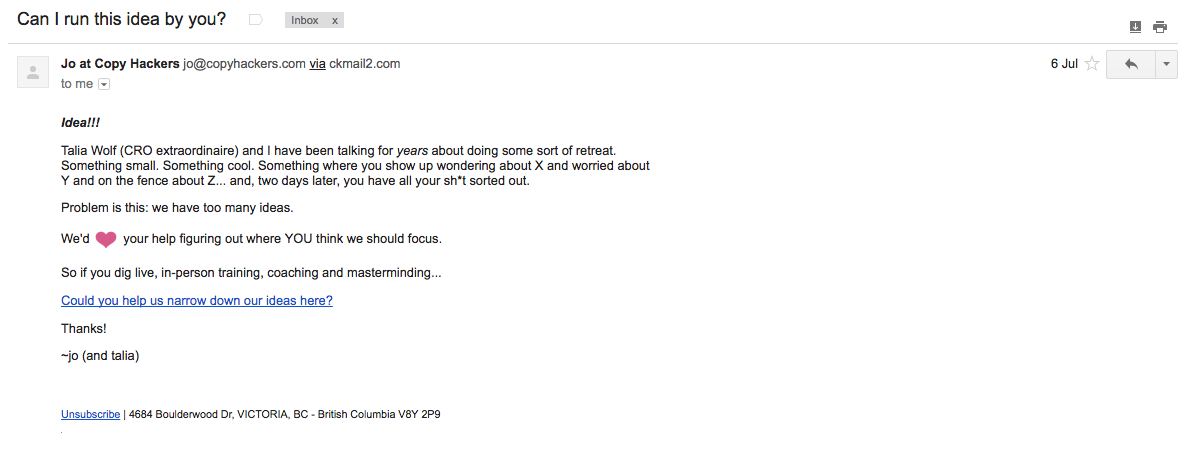
*A Survey Email example from Jo at Copy Hackers. *
Besides the obvious purpose of collecting feedback, survey emails can also be a wonderful way to establish a more personal connection with your following and start building trust. Your readers will appreciate the fact that you’re trying to help them by developing a product that matches their needs. In business, strong personal connections often translate into sales, as people tend to buy from people they like.
One thing you need to bear in mind when sending a survey email is staying neutral. Don’t mention your product or its price. Make sure your messaging is crystal clear – you want their help in the form of their opinion, not their money (yet).
Give Email
This is one of the wisest philosophies in life, and it works wonders in sales, too. If you strive to build a loyal following, the best thing to do is to give, give, give, and they will give back. As an effective method to build a sense of reciprocity, Give emails are an extremely popular tactic in presale and product launch campaigns for a reason. They work! However, it’s not enough to send your top 5 tips and expect people to feel grateful. You must ensure the content you share is highly valuable in the eyes of your readers.

*Neil Patel is a real practitioner of the give, give, give philosophy. *
It’s possible you’ll need to create this content specifically for the launch campaign, but you might just have something sitting in your drafts. The range of such giveaway content is broad; everything from templates, workbooks, video courses to audio files and 10x blog posts could do the trick.
Take your time to develop a content plan that caters to your interest list and give, give, give, for a chance to get something back.
Interest List Email
As the name implies, Interest List email helps you segment your subscribers into different lists based on their interests, position, skills, or anything else. For example, if you’re launching a new social media tool, you’ll find it useful to know who from your main list works in marketing. Besides, taking care to not bombard your subscribers with irrelevant emails is one of the cornerstones of ethical email marketing.
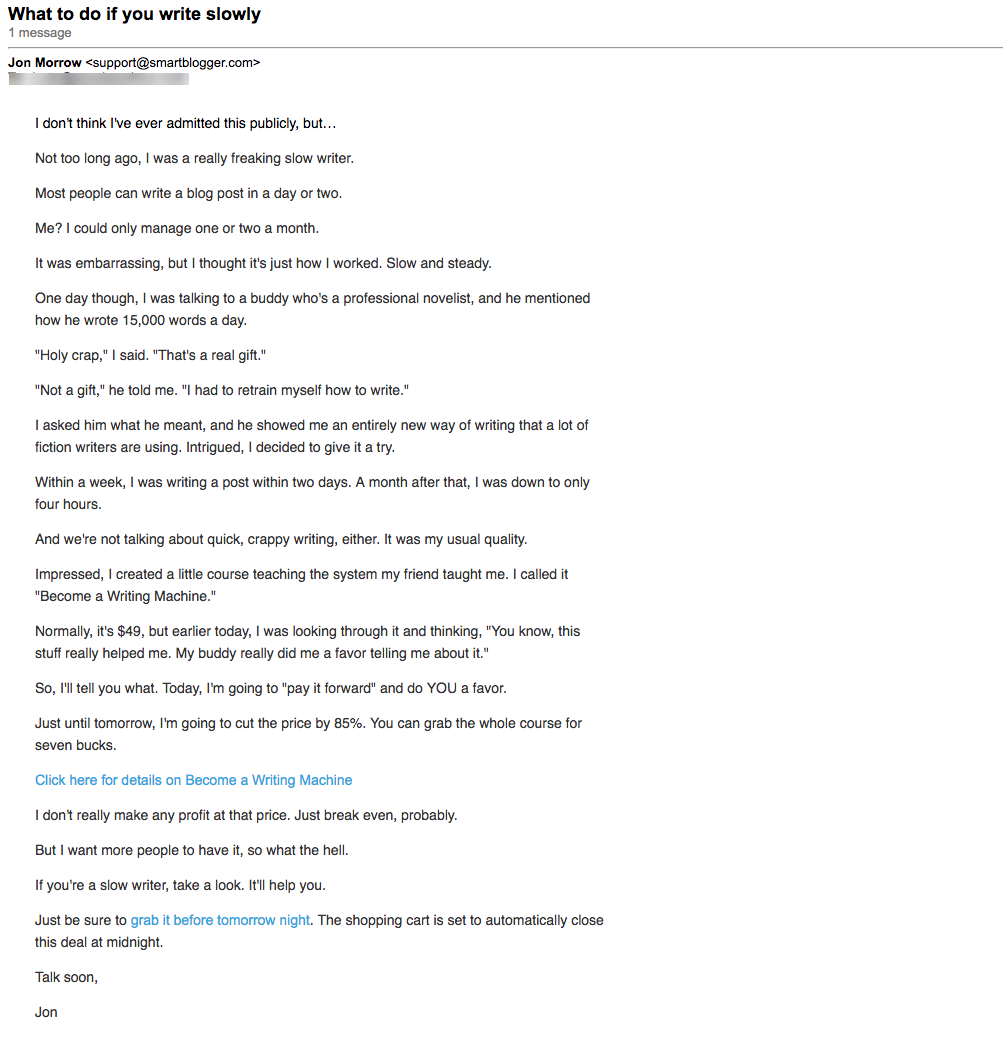
The Interest List email can also be used to build anticipation with your readers as well as identify the people who are interested to learn more about your launch right off the bat. However, it’s not an Offer email, so restrain from including too much information about the new product. You can mention the product or its benefits, but don’t go for a hard sale. Once you have the master list segmented into interest lists, you can then put your creative hat on and tell the story in a way that makes sense to that particular tribe.
Anticipation Email
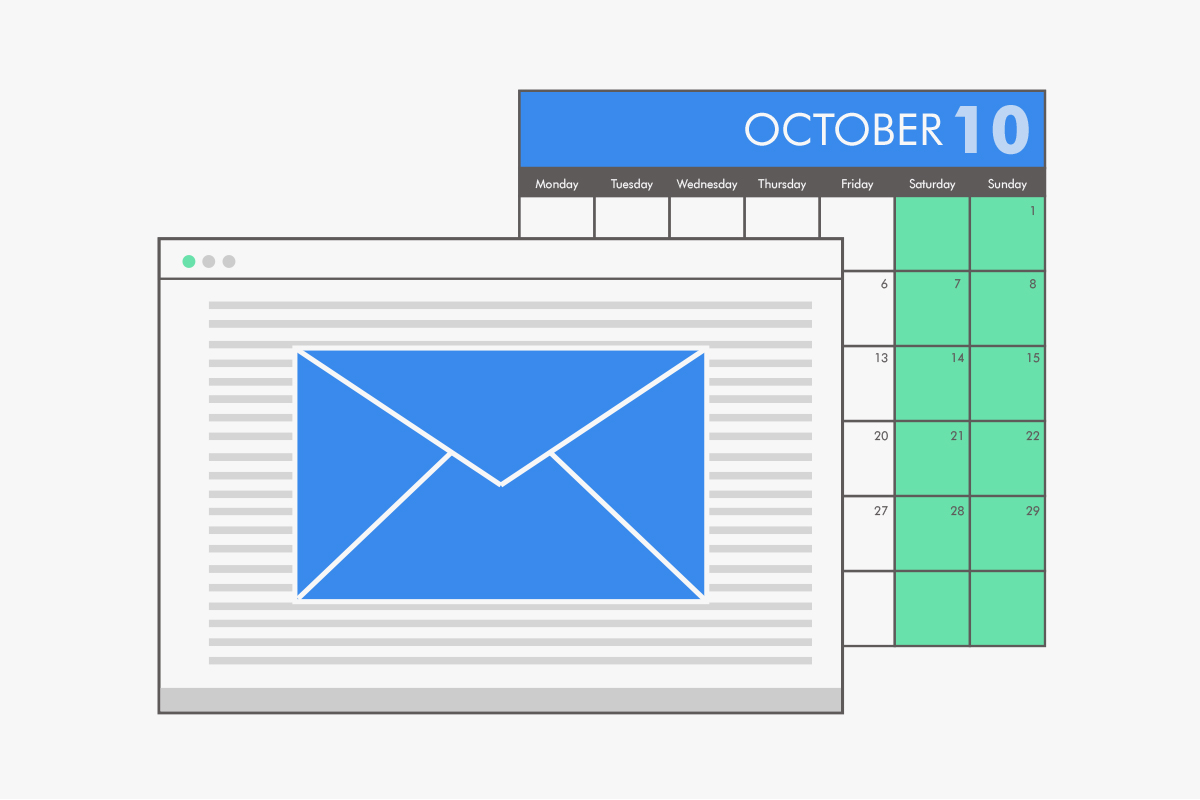
“Creating buzz” is one of those marketing phrases that send seasoned marketers into mental overload. Yet, if you manage to do what Apple does every September, you’re guaranteed to smash all expectations. The purpose of the anticipation email is to peak people’s curiosity and make them mark the day of your product launch in their work calendar. But how?
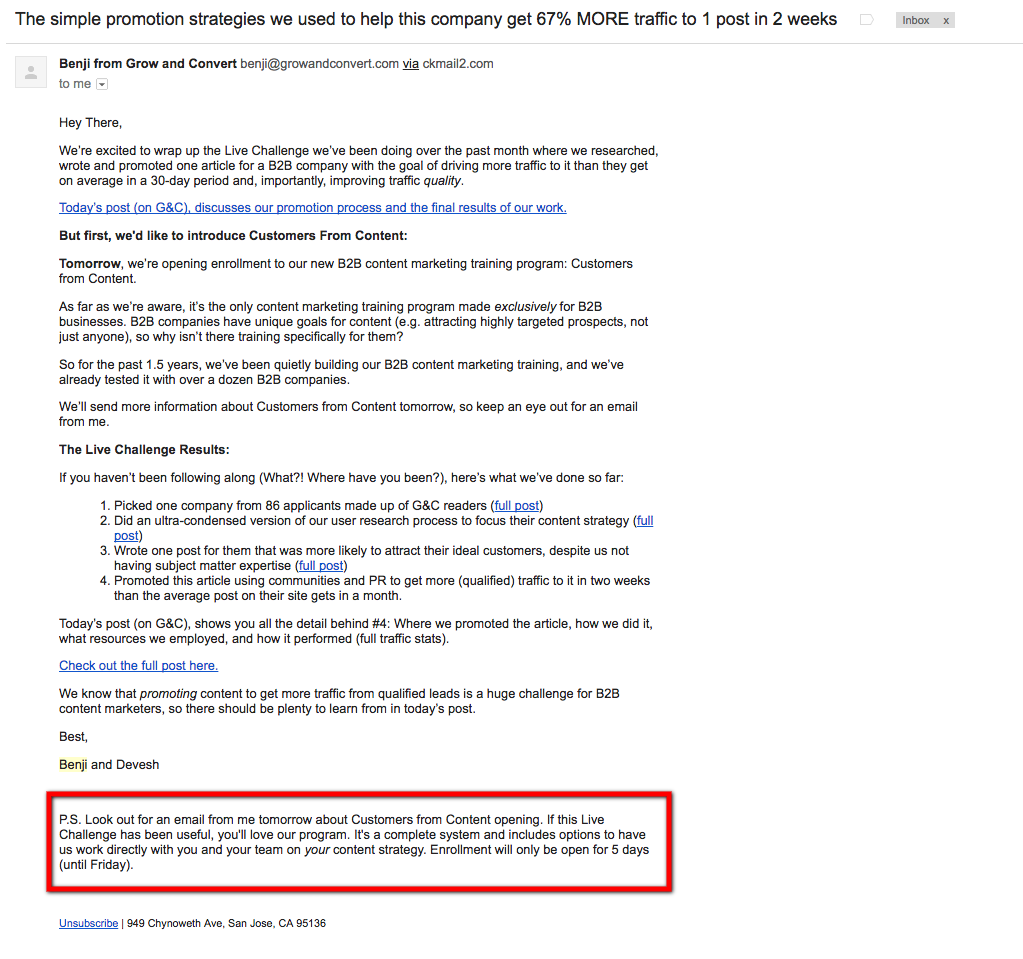
Anticipation email from Benji at Grow and Convert
Many have asked this same question in the past and arrived at the same answer – tell your story. Getting your readers excited, astonished, impressed or inspired is a surefire way to be remembered. Delving into the juicy WHY and sharing your personal story will help you humanize the sales journey and emphasize the impact their purchase will have on you. Think back to the last time you actually felt you should buy something because X – you need that X to nail your product launch email sequence.
Offer Email
This is the crescendo of everything you’ve been working on so far. Take a good aim, and make your killer pitch.
You can use different closing strategies to create urgency and scarcity, such as making a limited time offer or giving your subscribers a special discount code.
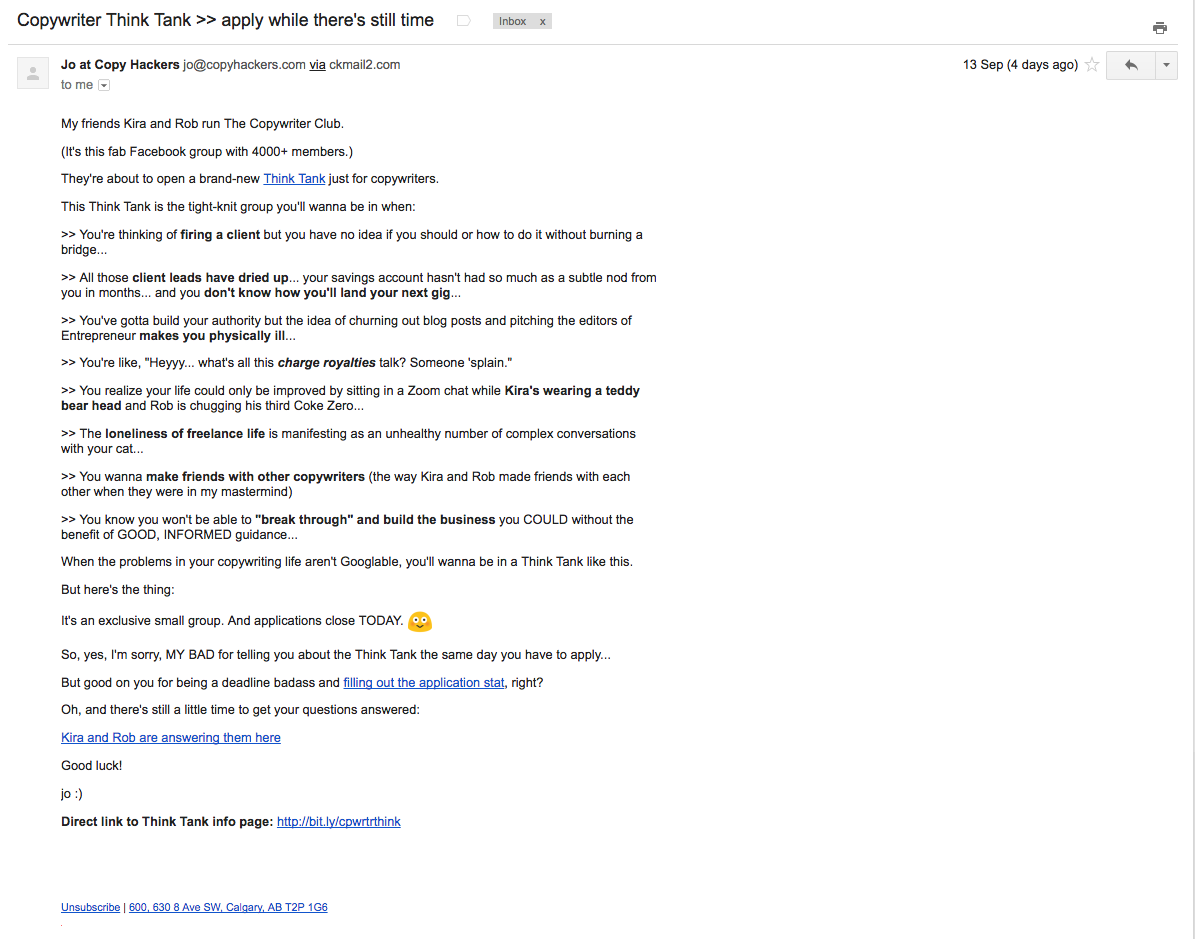
*Jo at Copy Hackers knows how to make the best of special offers. *
Make sure you inform your readers that the price will increase closer to launch to prompt them to act immediately. If you have the means to do it, you can redirect your readers to a special landing page that’s built with all the best practices in mind and taps into the psychology of buying. This would also give you an opportunity to highlight the best features of your product, showcase your portfolio, or reiterate the most compelling elements of your personal story.
Common Questions Email

Once the email sequence goes live, you’re likely to receive some questions from your audience. The Common Questions email is designed to address those most frequently asked questions, while also taking advantage of the social proof aspect. The fact that others are so actively pursuing the offer might encourage your more hesitant subscribers to learn more about your product or submit questions of their own.
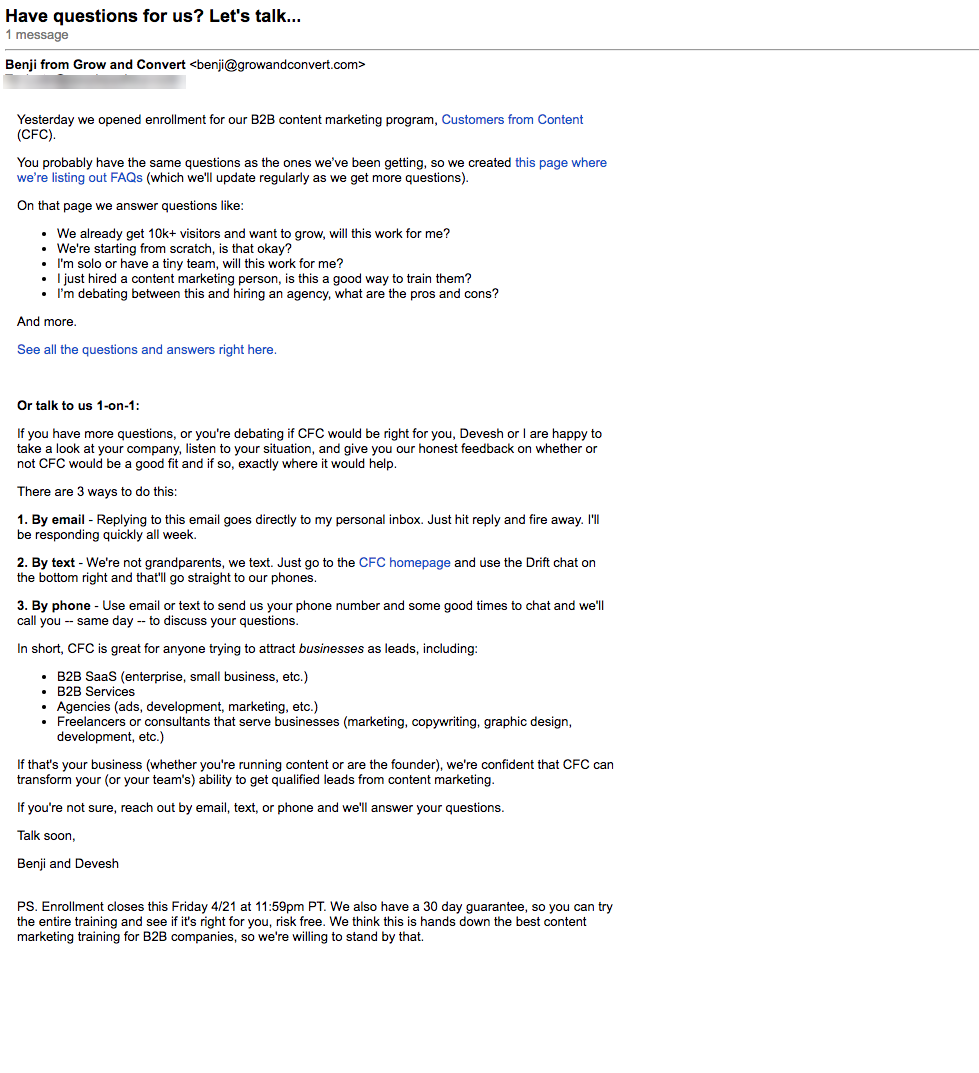
*A great example of the common questions email. *
Addressing the most common questions will allow you to save a lot of support time as well as encourage an open conversation with the less proactive subscribers.
Closing Email
That’s it, all good things must come to an end. This email gives your readers the last push and reminds them about what they’ll be missing out on if they fail to act now. If you ran special promotions, offered discounts or limited time offers, then you must let your subscribers know that the presale is ending and the price is about to increase significantly. To reinforce the message and give your email an edge, use the number or list of people who signed up. This will not only provide social proof, but might even create the FOMO effect.
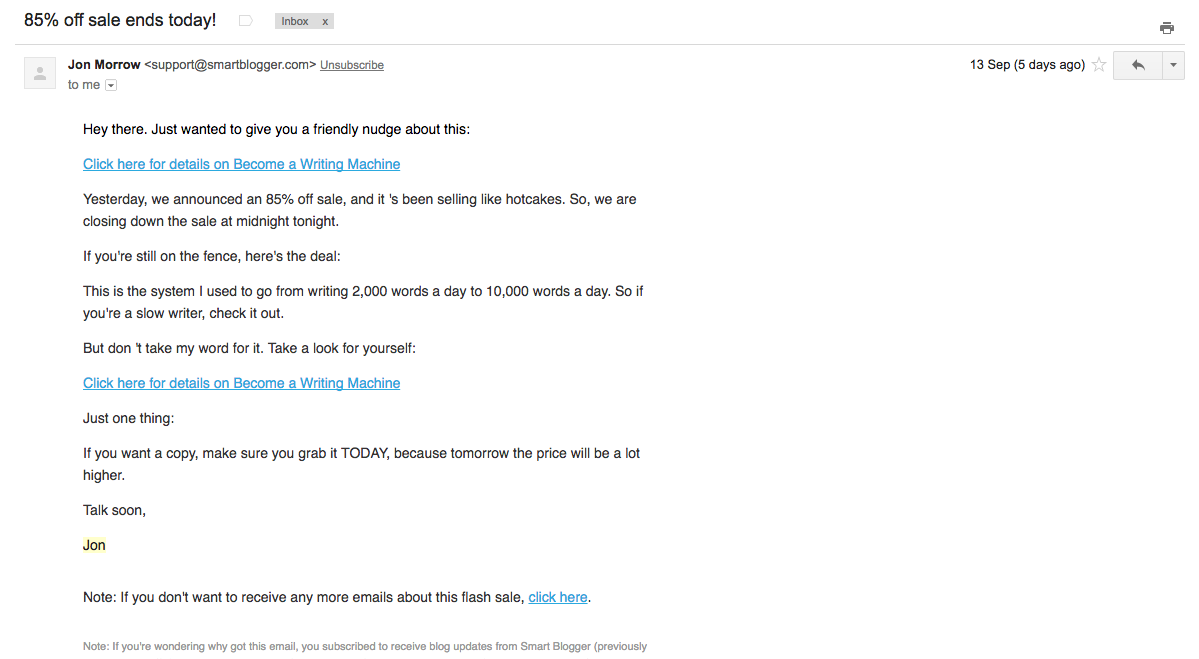
A reminder email from Jon Morrow.
If your audience is notorious for missing emails, think about scheduling a quick reminder – you’ll be surprised how upset people might get when they realize you “didn’t remind” them about the offer.
Conclusion
Think your product launch techniques might be a little wobbly? Don’t risk the success of your product. Take your time to study the best and most successful launches and build an email sequence that is guaranteed to do justice to your hard work. The inspiration and lessons you take away from other people’s strategies will give you the knowledge and confidence needed to orchestrate a spectacular product launch. Promise!
[thrive_leads id=’1873′]FAQ: product launch emails
How do you write a product launch email?
To write a product launch email, start with a catchy subject line that grabs the reader’s attention. Introduce the product in a clear and concise manner, highlighting its unique features and benefits. Use visuals like images or videos to showcase the product.
Include a clear call-to-action that directs the reader to take action, such as making a purchase or signing up for a free trial. Keep the email short, simple, and to the point.
What is a product launch email sequence?
A product launch email sequence is a series of emails sent to a targeted audience to promote and introduce a new product. It typically includes a pre-launch email to build anticipation, followed by emails highlighting features and benefits, social proof, and a call-to-action to purchase.
The goal is to educate, engage, and persuade subscribers to buy the product.
Which eCommerce platforms provide email marketing?
Sellfy is an eCommerce platform that provides email marketing features to its users. With Sellfy, sellers can easily create and send email campaigns to their customers to promote their products or sales.
The platform also offers customizable email templates, automated email sequences, and the ability to segment email lists based on customer behavior.





